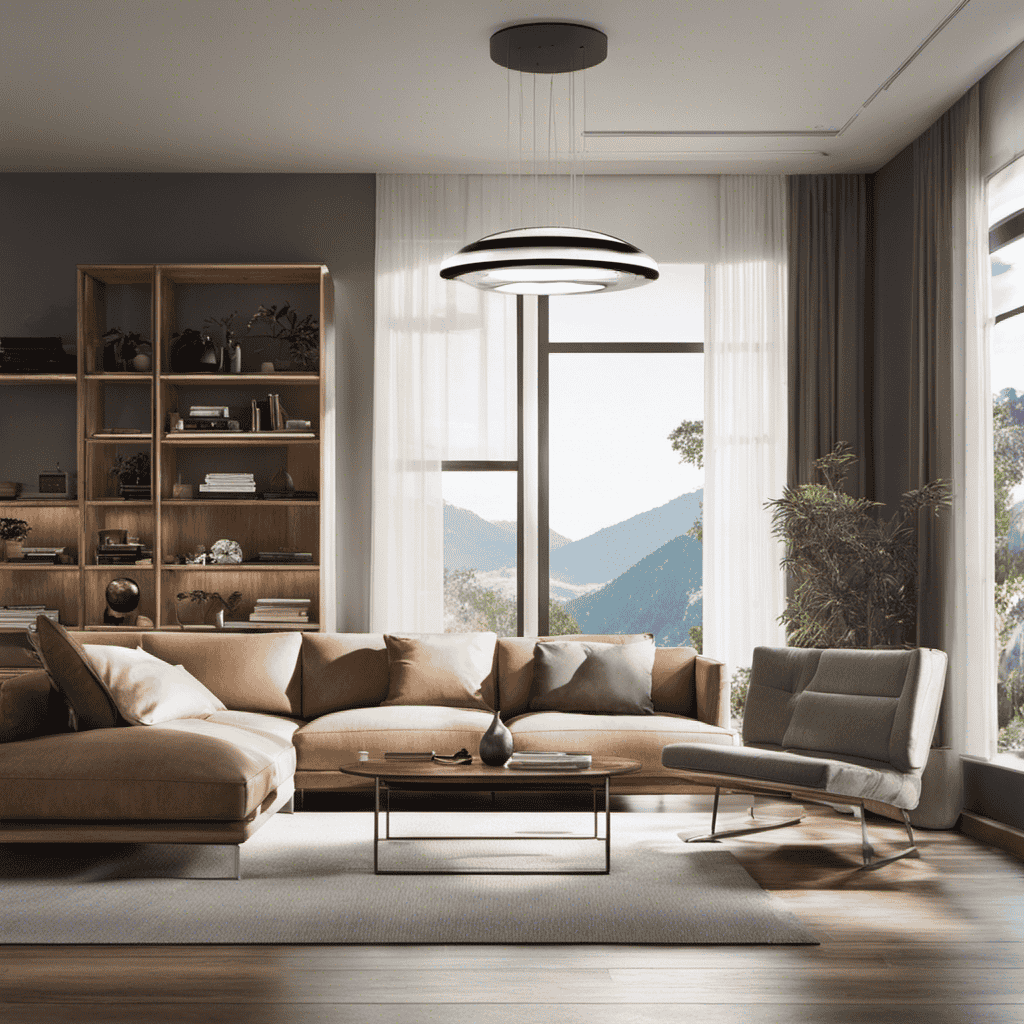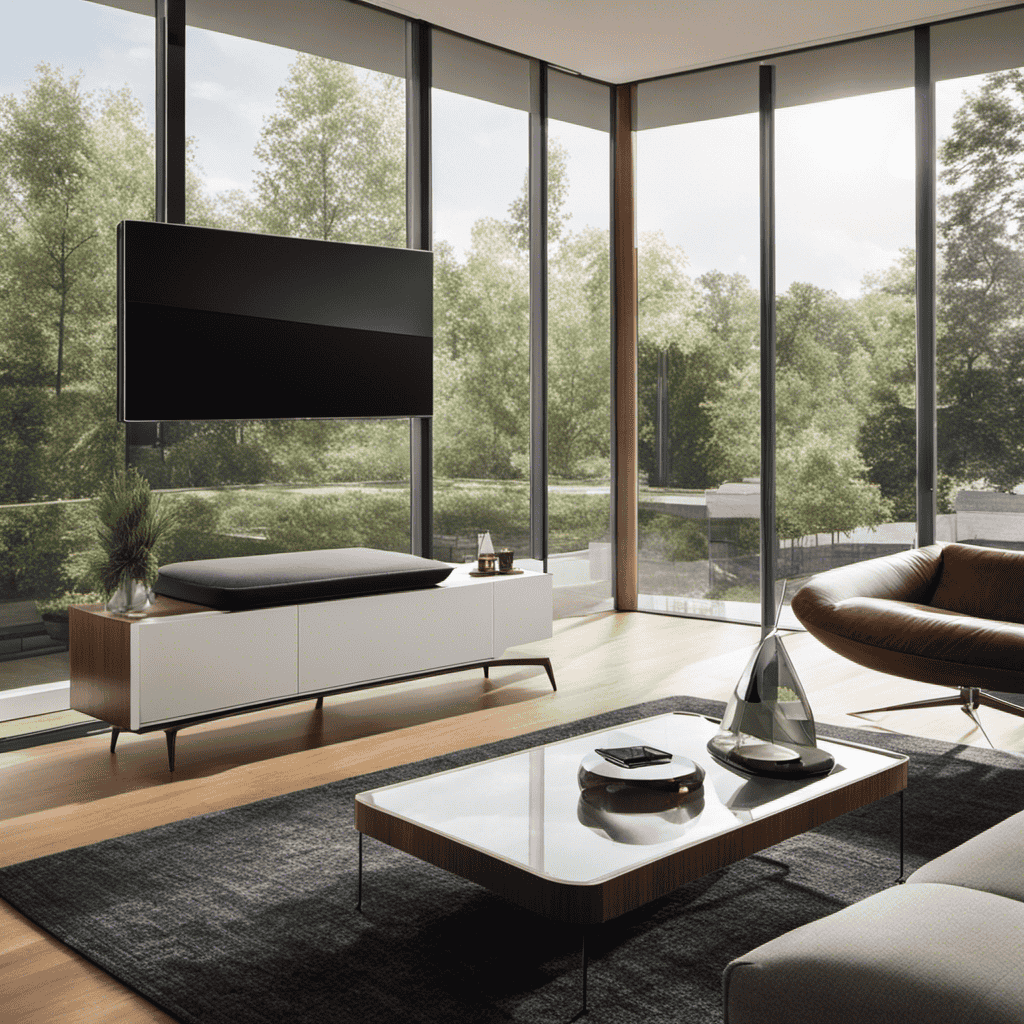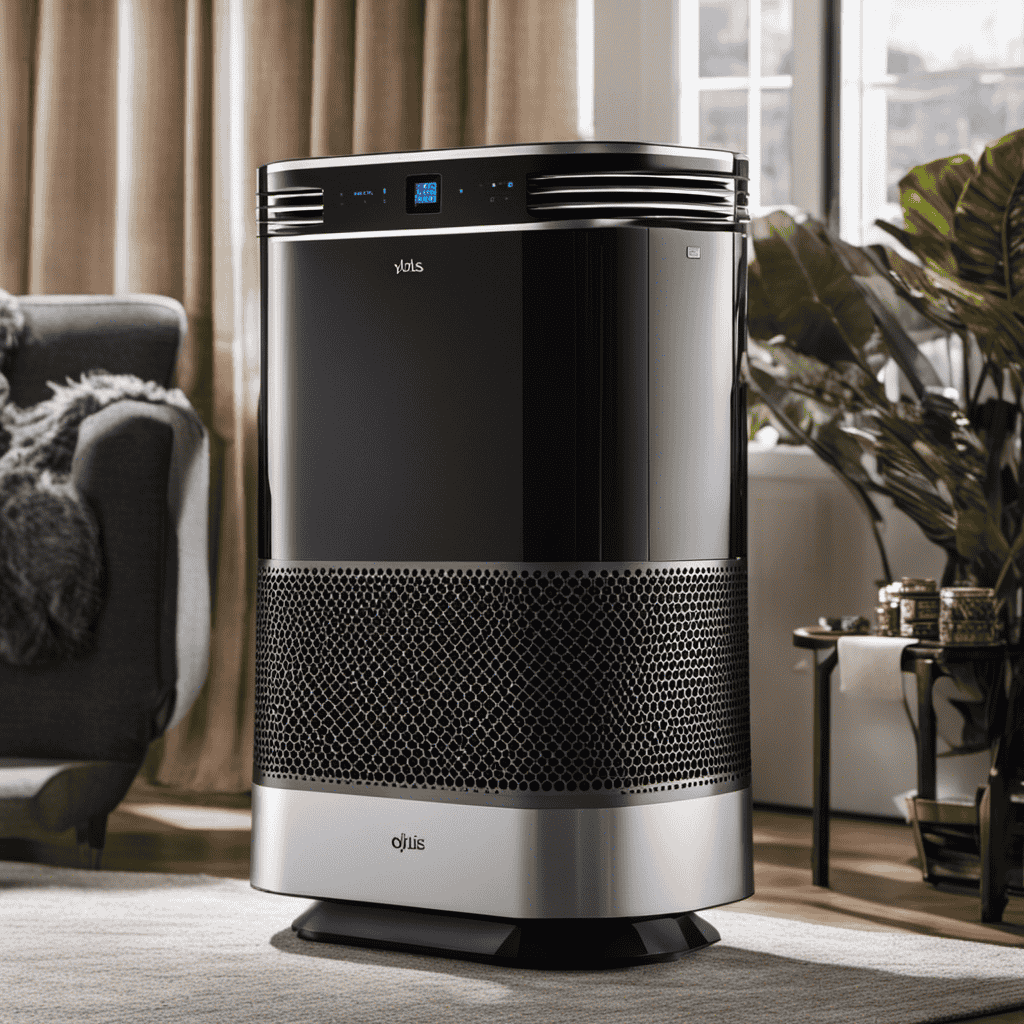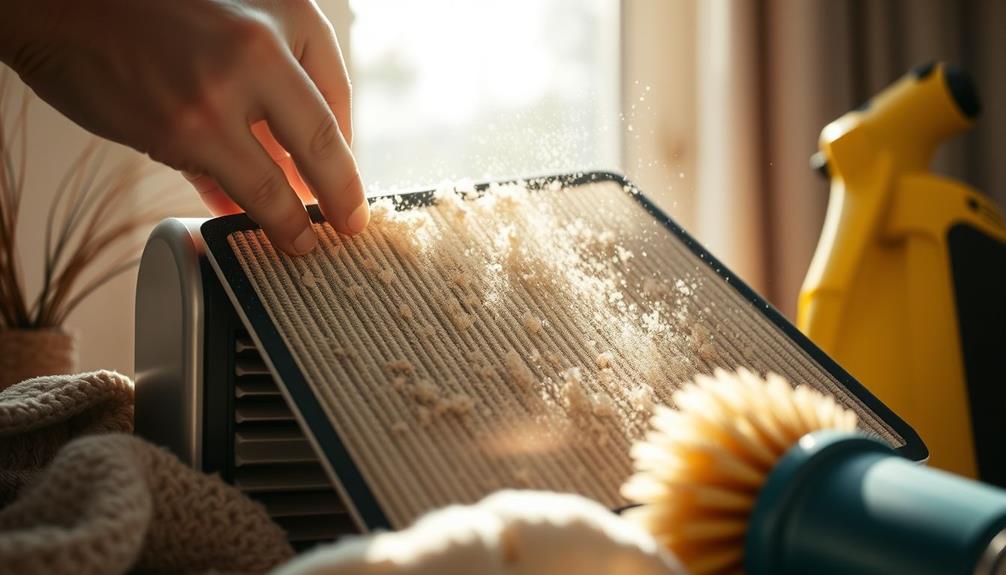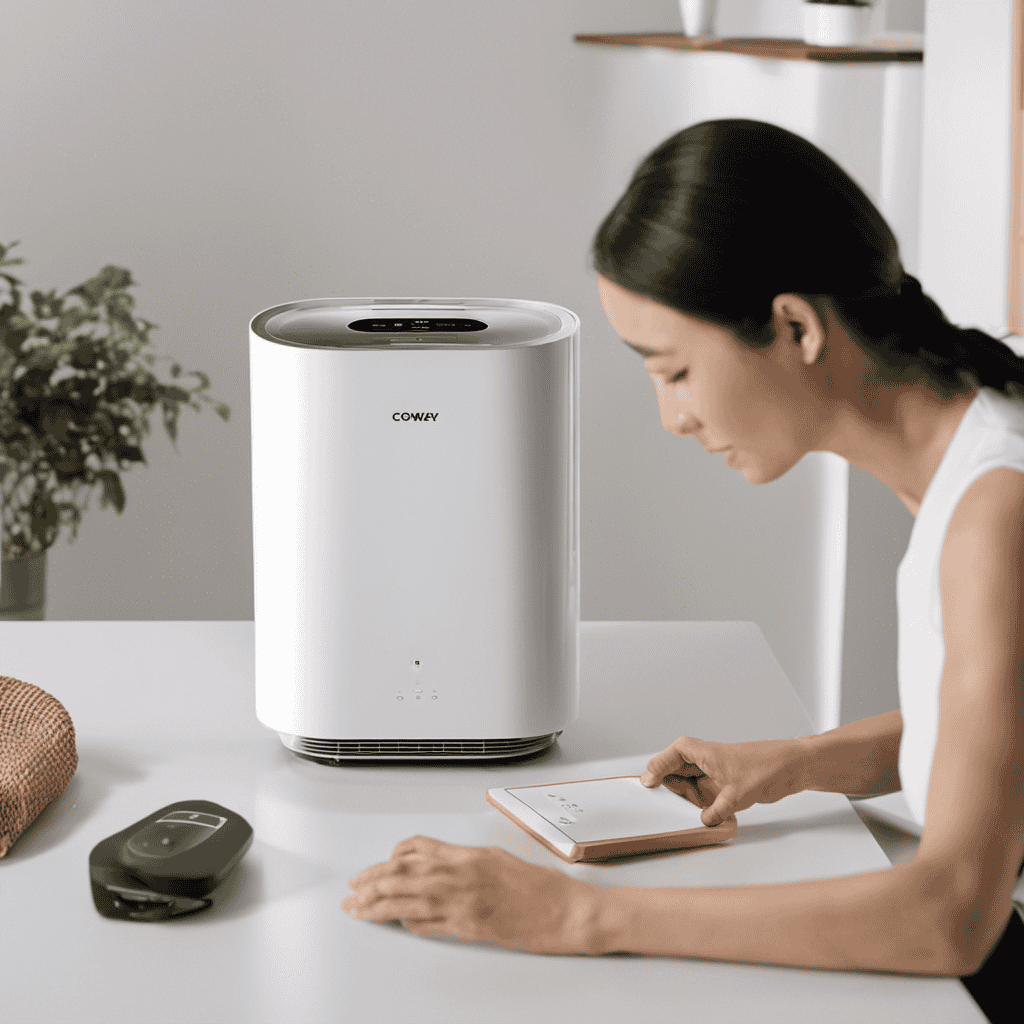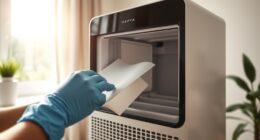Guess what? I found a magic trick to make dust in your home disappear—an air purifier!
But here’s the catch: it’s not just about having one, it’s about knowing where to put it.
In this article, I’ll guide you through the intricate process of finding the perfect spot for your air purifier.
From considering high-traffic areas to avoiding obstacles, we’ll explore the ideal locations in your living room, home office, kitchen, and more.
Get ready to breathe in clean, dust-free air like never before!
Key Takeaways
- Consider the size of the room and choose a powerful purifier accordingly.
- Ensure proper airflow by placing the air purifier away from obstructions like curtains or furniture.
- Identify areas with high dust concentration and place the purifier near those sources.
- Decide whether to place the purifier near windows to capture dust particles entering through them, while considering the impact on natural lighting.
Benefits of Placing an Air Purifier for Dust
You’ll love the benefits of placing an air purifier for dust in your home.
When it comes to the placement effectiveness of an air purifier for dust, it is crucial to consider the optimal airflow in your living space.
One of the best locations for an air purifier is in the center of the room, away from walls and furniture. This allows for better circulation and distribution of clean air throughout the space.
Placing the air purifier near sources of dust, such as windows or doors, can also improve its effectiveness in capturing airborne particles.
Additionally, positioning the device at a height of about 2-3 feet from the floor ensures that it can capture both settled dust and particles in the air.
Factors to Consider When Deciding the Placement of an Air Purifier for Dust
To effectively place an air purifier for dust, consider factors such as room size, airflow, and potential dust sources. When determining the ideal placement for your air purifier, keep in mind these three important considerations:
-
Room size: The size of the room where the air purifier will be used is crucial. A larger room may require a more powerful purifier to effectively remove dust particles. Conversely, a smaller room may benefit from a compact purifier.
-
Airflow: Proper airflow is essential for an air purifier to function optimally. Be sure to place the purifier in a location where it can effectively circulate the air in the room. Avoid placing it near obstructions such as curtains or furniture that may impede airflow.
-
Potential dust sources: Identify the main sources of dust in your home and place the air purifier strategically to target those areas. Common dust sources include carpets, pet areas, and windows. By placing the purifier near these sources, you can effectively reduce the amount of dust in your home.
Common mistakes when placing an air purifier for dust include placing it in a corner or behind furniture, which can restrict airflow and limit its effectiveness. Additionally, placing the purifier too far away from dust sources may result in inefficient dust removal.
Ideal Room Locations for an Air Purifier for Dust
When considering the placement of an air purifier for dust, it is important to evaluate whether the device should be placed in the bedroom or living room.
The bedroom is often considered a priority due to the fact that we spend a significant amount of time sleeping, and having clean air during this time is crucial for our overall well-being.
Additionally, it is worth considering whether the air purifier should be placed near windows or not, as windows can be a major source of dust and outdoor pollutants.
Lastly, the height at which the air purifier is placed can also impact its effectiveness, with some experts recommending placing it at a higher level to better capture and filter airborne particles.
Bedroom or Living Room
The best place to put an air purifier for dust is in either the bedroom or living room. These are the two most important areas where we spend a significant amount of time, and where we are likely to be exposed to the most dust particles.
Here are three factors to consider when deciding where to place your air purifier:
-
Proximity to the source of dust: It is essential to place the air purifier near the source of dust, such as an open window, a dusty carpet, or a pet’s bedding area. This ensures that the purifier can effectively capture and filter out the dust particles before they spread throughout the room.
-
Room size: Consider the size of the room when choosing the location for your air purifier. Larger rooms may require a more powerful purifier or multiple units to effectively clean the air.
-
Personal preference: It is vital to consider your personal preferences and lifestyle when deciding between the bedroom or living room. If you suffer from allergies or respiratory conditions, placing the air purifier in the bedroom can provide you with cleaner air while you sleep. However, if you spend more time in the living room, it may be more beneficial to place the purifier there to reduce dust exposure during your waking hours.
Overall, the benefits of air purifiers for dust are numerous, including reducing allergies, improving indoor air quality, and promoting better respiratory health. By considering these factors, you can choose the best location for your air purifier and enjoy cleaner and healthier air in your home.
Near Windows or Not
Placing an air purifier near windows can help reduce the amount of dust particles that enter your home. When positioned strategically, an air purifier can effectively capture dust particles that are carried in through open windows or blown in by the wind.
However, it is important to consider a few factors when deciding on the placement of your air purifier near windows. Firstly, make sure to keep the air purifier away from plants, as the airflow from the purifier can disrupt their growth and health.
Additionally, be mindful of the impact on natural light. While placing the purifier near a window may provide easier access to incoming dust particles, it can also obstruct the flow of natural light into the room.
Finding the right balance between dust reduction and natural lighting is key when deciding where to position your air purifier.
High or Low Placement?
To maximize effectiveness, consider whether placing the air purifier high or low would be more beneficial. Here are three factors to consider when deciding on the best room location for your air purifier:
-
Particle density: Dust, pet dander, and other pollutants tend to settle closer to the floor. Placing the air purifier low can help capture these particles more efficiently.
-
Air circulation: Placing the air purifier at a higher level can help improve air circulation in the room. This is especially important in larger spaces or rooms with limited airflow.
-
Odor control: If the main concern is eliminating odors, placing the air purifier higher up can help disperse clean air throughout the room more effectively.
Considering these factors, it is important to find the right balance between high and low placement for optimal air purification.
Now, let’s explore the benefits of placing an air purifier near high-traffic areas.
Placing an Air Purifier Near High-Traffic Areas
When it comes to placing an air purifier near high-traffic areas, there are two key points to consider: proximity to pollutants and optimal airflow placement.
Proximity to pollutants is important because it determines how effectively the air purifier can capture and filter the contaminants.
Placing the air purifier in a strategic location that allows for optimal airflow ensures that the purified air can circulate throughout the room, maximizing its efficiency in removing pollutants.
Proximity to Pollutants
Keeping an air purifier near sources of dust and other pollutants can greatly improve indoor air quality. The effectiveness of air purifiers in reducing airborne particles depends on several factors, including the proximity to the pollutants. Here are three key points to consider:
-
Placement: Position the air purifier as close as possible to the source of pollutants. For example, if you have a dusty area near a window, place the purifier nearby to capture the dust particles before they spread throughout the room.
-
Airflow: Ensure that the air purifier has sufficient airflow to effectively capture and filter the pollutants. Avoid obstructing the intake or exhaust vents, as this can hinder its performance.
-
Size and capacity: Choose an air purifier that is suitable for the size of the room or area you want to clean. A purifier with a higher Clean Air Delivery Rate (CADR) is generally more effective in larger spaces.
Optimal Airflow Placement
Placing the air purifier near the source of pollutants ensures optimal airflow for effective filtration.
When it comes to proximity to pets, it is important to consider the impact they have on air quality. Pets, such as cats and dogs, can shed fur and dander, which are common allergens and can contribute to poor indoor air quality.
By placing the air purifier close to areas where pets spend the most time, such as their bed or favorite resting spots, we can increase the chances of capturing these particles before they circulate throughout the room.
Additionally, it is recommended to keep the air purifier elevated off the ground to avoid any obstructions to the airflow. This strategic placement will maximize the purifier’s efficiency in removing pet-related pollutants and improving overall air quality in the room.
The Importance of Placing an Air Purifier Away From Obstacles
To ensure optimal performance, make sure you don’t block the airflow by placing the air purifier away from any obstacles. Adequate airflow is crucial for an air purifier to effectively remove airborne contaminants, such as dust, allergens, and pollutants. Here are three reasons why unobstructed airflow is essential:
-
Enhanced Air Circulation: Placing the air purifier in an open space allows for better circulation of air in the room. This ensures that the purifier can effectively capture and filter the dust particles present, improving the overall air quality.
-
Efficient Filtration: Obstructing the air purifier with objects like furniture or curtains can hinder the intake of air. This reduces the purifier’s ability to filter out dust particles, leading to poor performance and decreased effectiveness in removing allergens and pollutants.
-
Prevention of Overheating: Blocking the airflow of an air purifier can cause it to overheat. Overheating not only reduces its lifespan but also poses a potential fire hazard. By keeping the purifier away from obstacles, you can minimize the risk of overheating and ensure safe operation.
Should You Put an Air Purifier for Dust Near Windows or Doors
When considering the ideal location for an air purifier for dust, one important factor to consider is whether it should be placed near windows or doors.
Both windows and doors are common sources of outdoor air pollutants, such as pollen, dust, and exhaust fumes, which can negatively impact indoor air quality. By placing the air purifier near windows or doors, it can effectively capture and remove these pollutants before they enter the room, resulting in cleaner and healthier air.
However, it is also important to ensure that the air purifier is placed in an area where it can effectively circulate the air throughout the room, taking into account factors such as room size and layout.
Window or Door Placement
For optimal effectiveness, it’s important to consider whether to place the air purifier near a window or door. When deciding where to position your air purifier, keep in mind the following factors:
-
Airflow: Placing the air purifier near a window or door can help in maximizing the circulation of air in the room. This can be beneficial for capturing dust particles that may enter through these openings.
-
Proximity to Dust Sources: If there are specific windows or doors through which dust enters your space, positioning the air purifier nearby can help in capturing the dust particles before they spread further.
-
Obstruction-Free Placement: Ensure that the air purifier is not obstructed by any furniture or objects near the window or door. This will allow for unobstructed airflow and better dust removal.
Ideal Air Purifier Location?
Consider placing your air purifier near a window or door to maximize its effectiveness. The ideal air purifier placement can greatly enhance its ability to filter and clean the air in your home.
By positioning the air purifier near a window or door, it can capture and filter out outdoor pollutants that may enter your living space. This strategic placement allows the purifier to draw in fresh air from outside, which can help dilute indoor pollutants and maintain good air quality.
Additionally, having the air purifier near a window or door can create better air circulation, ensuring that the purified air is evenly distributed throughout the room.
The benefits of proper air purifier placement include improved air quality, reduced dust, allergens, and other airborne particles, leading to a healthier living environment.
Placing an Air Purifier for Dust in Bedrooms
To effectively reduce dust in bedrooms, it’s important to place an air purifier in the right location. Here are three key factors to consider when determining the placement of your air purifier:
-
Bedroom Size: The size of your bedroom plays a crucial role in deciding where to put the air purifier. For smaller bedrooms, placing the purifier near the center of the room ensures better air circulation. In larger bedrooms, it’s best to position the purifier closer to the areas where you spend the most time, such as near your bed or workstation.
-
Noise Level: Consider the noise level of the air purifier before deciding on its placement. If you’re a light sleeper, it’s advisable to position the purifier further away from your bed to minimize any noise disruption. However, make sure it’s still within the effective range to filter the air effectively.
-
Airflow Direction: The airflow direction of your air purifier is another critical factor. Ideally, you want the purifier to pull in the dust-laden air from your bedroom and release clean, purified air back into the room. Place the purifier in a location that allows for proper circulation and airflow throughout the entire room.
The Effectiveness of Placing an Air Purifier for Dust in Living Rooms
When placing an air purifier in your living room, it’s important to find the optimal location for maximum effectiveness.
The ideal placement for an air purifier in the living room is near the area where the most activity occurs, such as where you spend the most time or where pets tend to stay. This ensures that the air purifier can effectively remove dust particles and other pollutants from the air, improving the overall air quality in your living space.
The benefits of air purifiers in living rooms are numerous. They can help reduce allergens, such as dust mites and pet dander, which can be especially beneficial for individuals with allergies or asthma. Additionally, air purifiers can help remove odors from cooking or smoking, creating a fresh and clean living environment.
Where to Put an Air Purifier for Dust in Your Home Office
For maximum effectiveness, place an air purifier in your home office where it will capture and remove dust particles from the air you breathe while working.
The ideal placement for an air purifier in your home office is near your desk or work area, ensuring that the air you are directly exposed to is clean and free of dust.
Here are three benefits of placing an air purifier in your home office:
-
Improved Air Quality: An air purifier will filter out dust particles, allergens, and other pollutants, resulting in cleaner air for you to breathe. This can help reduce respiratory issues and allergies, allowing you to work in a healthier environment.
-
Increased Productivity: Breathing in clean air can enhance cognitive function and concentration, leading to increased productivity and focus while working in your home office.
-
Reduced Cleaning Time: By capturing dust particles from the air, an air purifier can help minimize the amount of dust that settles on surfaces in your home office. This means less time spent on cleaning and more time spent on your work.
Placing an air purifier for dust in the kitchen or dining area can also be beneficial, as it will help eliminate cooking odors and remove airborne particles that can settle on food surfaces.
Placing an Air Purifier for Dust in the Kitchen or Dining Area
Placing an air purifier in the kitchen or dining area can effectively eliminate cooking odors and airborne particles that settle on food surfaces. The kitchen is a common area where cooking activities generate a significant amount of dust and pollutants. By utilizing an air purifier, you can ensure that the air you breathe while preparing meals is clean and free from harmful particles.
Kitchen ventilation plays a crucial role in maintaining good indoor air quality. However, it may not always be sufficient to eliminate all airborne pollutants. An air purifier can complement kitchen ventilation systems by capturing and removing particles that may escape from the cooking area.
When considering dust prevention strategies, placing an air purifier near the kitchen or dining area is essential to create a healthier and cleaner environment for you and your family.
Now, let’s explore considerations for placing an air purifier for dust in open floor plans.
Considerations for Placing an Air Purifier for Dust in Open Floor Plans
Utilizing an air purifier in open floor plans can effectively improve indoor air quality and reduce the presence of airborne particles. When considering the ideal location and optimal placement for an air purifier in an open floor plan, there are several key factors to keep in mind:
-
Centralized Positioning: Placing the air purifier in a central location ensures that it can effectively circulate and clean the air throughout the entire space. This helps to minimize the accumulation of dust and other pollutants in specific areas.
-
Adequate Airflow: It’s important to ensure that there is proper airflow around the air purifier. Avoid placing it near walls or furniture that could obstruct the intake or output vents, as this can hinder its performance.
-
Distance from Obstacles: Keep the air purifier at a safe distance from any obstacles or obstructions, such as curtains or large pieces of furniture. This allows for optimal air circulation and ensures that the purifier can effectively capture dust particles from the entire room.
Conclusion
In conclusion, it is clear that the ideal room locations for placing an air purifier for dust depend on the specific needs and layout of your home. Placing an air purifier near high-traffic areas may seem logical, but obstacles that hinder its effectiveness should also be considered. The living room, home office, and kitchen/dining area are prime locations for reducing dust particles. However, in open floor plans, careful consideration must be given to ensure optimal coverage.
So, dear readers, when it comes to placing your air purifier for dust, remember that science and satire can go hand in hand, creating a cleaner and more enjoyable living environment. Happy purifying!
